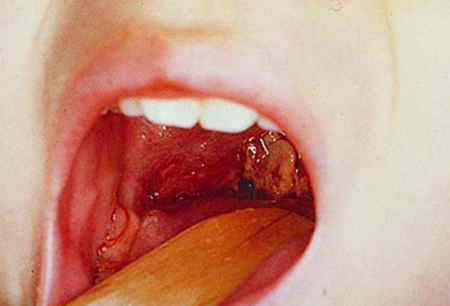Aetiology
Your Organisational Guidance
ebpracticenet urges you to prioritise the following organisational guidance:
Acute KeelpijnPublished by: Werkgroep Ontwikkeling Richtlijnen Eerste Lijn (Worel)Last published: 2017Mal de gorge aiguPublished by: Groupe de Travail Développement de recommmandations de première ligneLast published: 2017Acute sore throat is most commonly due to viral organisms or group A Streptococcus (GAS). Common viral causes include the Epstein-Barr virus (mononucleosis), adenoviruses, enteroviruses, influenza A and B, and parainfluenza. GAS pharyngitis, also known as strep throat, is caused by S pyogenes and spreads from person to person, especially in the winter, via the respiratory droplet route; however, it represents less than one third of all cases of acute pharyngitis.[1][4][17] Group B, C, and G streptococci can cause pharyngitis that is clinically indistinguishable from GAS.[18][19]
Humans are the only reservoir for GAS.[4] Transmission of GAS pharyngitis from infected individuals to close contacts occurs frequently through saliva, wound exudates, or nasal secretions.[4] The incubation period of GAS is approximately 2-5 days.[4]
Other bacteria found rarely in adolescents with pharyngitis include Mycoplasma species, Fusobacterium necrophorum, and Arcanobacterium haemolyticum.[20][21]
HIV, chlamydia, or gonorrhoea may be implicated as a cause of acute pharyngitis in sexually active adolescents or sexually abused children.[8]
In countries with low vaccination rates, diphtheria and measles are also possible causes of acute pharyngitis.
Tularaemia may be a cause if there is a history of eating meat from undomesticated animals.[9][13][7]
Candida infection is common as a source of sore throat in immunocompromised individuals, including those undergoing chemotherapy or oropharyngeal irradiation for cancer.[5]
Pathophysiology
Acute pharyngitis results from viral or bacterial invasion of the pharyngeal mucosa, resulting in inflammation of the pharynx. Most commonly, the disease is localised to the pharynx alone, but rarely it may be part of a systemic infection (e.g., infectious mononucleosis, tularaemia, or HIV).
Classification
Clinical classification of pharyngitis
Group A Streptococcus (GAS) pharyngitis:
Presence of fever, sore throat, pharyngeal exudate, cervical adenopathy, and lack of cough.
Viral pharyngitis:
Common viral causes include the severe acute respiratory syndrome coronavirus 2 (SARS-CoV-2), Epstein-Barr virus (mononucleosis), adenoviruses, enteroviruses, influenza A and B, and parainfluenza
May or may not have pharyngeal exudate
Infectious mononucleosis is often accompanied by lymphadenopathy and splenomegaly[3]
Diagnosis supported by a negative culture
Symptoms include: cough, rhinorrhoea, hoarseness, oral ulcers, conjunctivitis[4]
When a patient shows clear viral symptoms, diagnosis can be made based on history and clinical examination.[4]
Candidal pharyngitis:
Common in immunocompromised individuals
May accompany chemotherapy or irradiation for oropharyngeal cancer.[5]
Diphtheria:
Grey membrane in the nose and throat that bleeds when dislodged[Figure caption and citation for the preceding image starts]: Typical pseudomembrane of diphtheria pharyngitisCopyright Department of Paediatrics and Adolescent Medicine, Princess Margaret Hospital, Hong Kong; used with permission [Citation ends].

Rare outside low- and middle-income countries.
Measles:
Associated with conjunctivitis, rhinitis, cough, and characteristic exanthem (eruptive skin rash)
Koplik spots (bluish-white, raised lesions on an erythematous base on the buccal mucosa) are pathognomonic.[6]
Tularaemia:
Results from eating or drinking contaminated food or water[7]
Oropharyngeal tularaemia symptoms include: sore throat, mouth ulcers, tonsillitis, and swelling of lymph glands in the neck[7]
Ulcerations and exudates in the pharynx
May develop grey membrane (mimicking diphtheria)[8]
Unresponsive to penicillin therapy
Associated with ingestion of raw or undercooked meat from non-domestic animals. European Centre for Disease Prevention and Control: factsheet on tularaemia Opens in new window[9][7]
Sexually transmitted pharyngitis (in sexually active or abused individuals):[10]
Acute HIV
Gonorrhoea
Chlamydia.
Lemierre's syndrome:
Most commonly due to Fusobacterium necrophorum infection[11]
Involves septic thrombophlebitis of the jugular vein[12]
Requires inpatient care.
Retropharyngeal abscess:
Fever, sore throat, difficulty swallowing, neck pain/stiffness, vocal changes
Diagnosis by CT
Requires inpatient care.
Use of this content is subject to our disclaimer